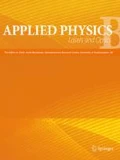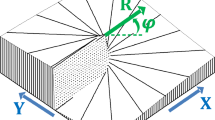Abstract
The invention of the laser immediately enabled the detection of nonlinear photon–matter interactions, as manifested for example by Franken et al.’s detection of second-harmonic generation.
With the recent advancement in high-power, high-energy lasers and the examples of nonlinearity studies of the laser-matter interaction by virtue of properly arranging lasers and detectors, we envision the possibility of probing nonlinearities of the photon interaction in vacuum over substantial space-time scales, compared to the microscopic scale provided by high-energy accelerators.
Specifically, we introduce the photon–photon interaction in a quasi-parallel colliding system and the detection of higher harmonics in that system. The method proposed should realize a far greater sensitivity of probing possible low-mass and weakly coupling fields that have been postulated.
With the availability of a large number of coherent photons, we suggest a scheme for the detection of higher harmonics via the averaged resonant production and decay of these postulated fields within the uncertainty of the center-of-mass energy between incoming laser photons.
The method carves out a substantial swath of new experimental parameter regimes on the coupling of these fields to photons, under appropriate laser technologies, even weaker than that of gravity in the mass range well below 1 eV.
Similar content being viewed by others
References
C. Amsler et al. (Particle Data Group) Phys. Lett. B 667, 1 (2008) and 2009 partial update for the 2010 edition. See section for Axions and other similar particles
B. Holdom, Phys. Lett. B 166, 196 (1986)
B. Batell, T. Gherghetta, Phys. Rev. D 73, 045016 (2006). arXiv:hep-ph/0512356
S.A. Abel, J. Jaeckel, V.V. Khoze, A. Ringwald, Phys. Lett. B 666, 66 (2008). arXiv:hep-ph/0608248
H. Gies, J. Jaeckel, A. Ringwald, Phys. Rev. Lett. 97, 140402 (2006). arXiv:hep-ph/0607118
Y.F. Cai, E.N. Saridakis, M.R. Setare, J.Q. Xia, Quintom cosmology: theoretical implications and observations, arXiv:0909.2776 [hep-th]
S. Tsujikawa, Dark energy: investigation and modeling. arXiv:1004.1493 [astro-ph.CO]
Y. Fujii, K. Maeda, The Scalar-Tensor Theory of Gravitation (Cambridge University Press, Cambridge, 2003)
S. Weinberg, Phys. Rev. Lett. 19, 1264 (1967)
G.A. Mourou, T. Tajima, S.V. Bulanov, Rev. Mod. Phys. 78, 309 (2006)
T. Tajima, K. Mima, H. Baldis (eds.), High Field Science (Kluwer Academic/Plenum, New York, 2000)
T. Tajima, Eur. Phys. J. D 55, 519 (2009)
A.T. Forrester, R.A. Gudmundsen, P.O. Johnson, Phys. Rev. 99, 1691 (1955)
Y. Minami, T. Yogi, K. Sakai, Phys. Rev. A 78, 033822 (2008)
P. Franken, A.E. Hill, C.W. Peters, G. Weinreich, Phys. Rev. Lett. 7, 118 (1961)
W. Heisenberg, H. Euler, Z. Phys. 98, 714 (1936). arXiv:physics/0605038
V. Weisskopf, K. Dan. Vidensk. Selsk. Skr., Nat.vidensk. Math. Afd. XIV, 166 (1936)
H.J. de Vega, N.G. Sanchez, astro-ph/0701212
In preparation for Appl. Phys. B
K. Homma, in AIP Conference Proceedings, vol. 1153, pp. 49–60 (2009). arXiv:0911.5701v1 [quant-ph]
R. Cameron et al., Phys. Rev. D 47, 3707 (1993)
E. Zavattini et al. (PVLAS Collaboration), Phys. Rev. D 77, 032006 (2008). arXiv:0706.3419 [hep-ex]
C. Robilliard, R. Battesti, M. Fouche, J. Mauchain, A.M. Sautivet, F. Amiranoff, C. Rizzo, Phys. Rev. Lett. 99, 190403 (2007). arXiv:0707.1296 [hep-ex]
M. Fouche et al., Phys. Rev. D 78, 032013 (2008)
K. Ehret et al., Production and detection of axion-like particles in a HERA dipole magnet: Letter-of-intent for the ALPS experiment. arXiv:hep-ex/0702023
A.V. Afanasev, O.K. Baker, K.W. McFarlane, Production and detection of very light spin-zero bosons at optical frequencies. arXiv:hep-ph/0605250
A. Afanasev et al., Phys. Rev. Lett. 101, 120401 (2008). arXiv:0806.2631 [hep-ex]
P. Pugnat et al. (OSQAR Collaboration), Phys. Rev. D 78, 092003 (2008). arXiv:0712.3362 [hep-ex]
A.S. Chou et al. (GammeV (T-969) Collaboration), Phys. Rev. Lett. 100, 080402 (2008). arXiv:0710.3783 [hep-ex]
A.S. Chou et al. (GammeV Collaboration), Phys. Rev. Lett. 102, 030402 (2009). arXiv:0806.2438 [hep-ex]
Y. Fujii, K. Homma, An approach toward the laboratory search for the scalar field as a candidate of Dark Energy. arXiv:1006.1762 [gr-qc]
http://www.extreme-light-infrastructure.eu/. See also http://www.eli-np.ro/documents/meeting-10-12marchPresentations/11-03-2011/Experiments/Homma-ELI-NP-Buchrest-Mar10-12.pdf
For example, see section for Cross-section formulae for specific processes in Amsler et al. (Particle Data Group), Phy. Lett. B 667, 1 (2008) and 2009 partial update for the 2010 edition
A. Yariv, Optical Electronics in Modern Communications (Oxford University Press, Oxford, 1997)
The complicated analytic solution of the integral is found. We have checked the behavior of the solution around the width a
For example, see Fig. 2 and Sect. 4 in J. Jaeckel and A. Ringwald, The Low-Energy Frontier of Particle Physics. arXiv:1002.0329 [hep-ph]
For example see R. Loudon, The Quantum Theory of Light, 3rd edn. (Oxford University Press, New York, 2000)
B. Dobrich, H. Gies, J. High Energy Phys. 1010, 022 (2010). arXiv:1006.5579 [hep-ph]
B. Dobrich, H. Gies, High-intensity probes of axion-like particles. arXiv:1010.6161 [hep-ph]
V.G. Bordo, Opt. Commun. 132, 62 (1996)
W. Dittrich, H. Gies, Probing the Quantum Vacuum (Springer, Berlin, 2007). See p. 183
C. Amsler et al. (Particle Data Group), Phy. Lett. B 667, 1 (2008) and 2009 partial update for the 2010 edition. See section for High-energy collider parameters
D.N. Spergel et al., Astrophys. J. Suppl. Ser. 148, 175 (2004)
J. Schwinger, Phys. Rev. 82, 664 (1951)
A.G. Riess et al., Astron. J. 116, 1009 (1998)
S. Perlmutter et al., Nature 391, 51 (1998)
Author information
Authors and Affiliations
Corresponding author
Rights and permissions
About this article
Cite this article
Homma, K., Habs, D. & Tajima, T. Probing the semi-macroscopic vacuum by higher-harmonic generation under focused intense laser fields. Appl. Phys. B 106, 229–240 (2012). https://doi.org/10.1007/s00340-011-4567-3
Received:
Revised:
Published:
Issue Date:
DOI: https://doi.org/10.1007/s00340-011-4567-3




